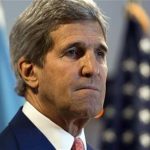ODESSA, Ukraine (AP) — Ukraine’s prime minister on Sunday visited the city where a horrific blaze killed dozens of pro-Russian demonstrators during political riots — seeking to defuse mounting tensions by calling the deaths a tragedy for all Ukraine.

Arseniy Yatsenyuk said police were being investigated for their failure to maintain order in Friday’s violence, while hinting strongly that he sees Moscow’s hand in the events.
This is not a tragedy only for Odessa, Yatsenyuk said. This is a tragedy for all Ukraine.
The prime minister said he has charged prosecutors with finding all instigators, all organizers and all those that under Russian leadership began a deadly attack on Ukraine and Odessa.
More than 40 people died in the unrest — some from gunshot wounds, but most in a fire that tore through a trade union building.
Odessa is the major city between the Crimean peninsula, which Russia annexed in March, and the Moldovan separatist region of Trans-Dniester where Russia has a military peacekeeping contingent. Concerns are mounting that Russia ultimately aims to take control of a huge swath of Ukraine from Trans-Dniester to the east.
Yatsenyuk’s visit came as Ukrainian authorities renewed their push to quell a pro-Russian insurgency in the east. Interior Minister Arsen Avakov said in a statement on his Facebook page that an antiterrorist operation was being executed in the eastern city of Kramatorsk, the latest flashpoint for unrest.
The operation was carried out by fighters of the National Guard and the armed forces. The active phase resumed at dawn. We will not stop, Avakov wrote.
The city saw a standoff Saturday that culminated in pro-Russian insurgents setting buses alight to ward off attacks. Russian state television has reported 10 deaths, including two among government forces, during clashes in Kramatorsk so far. Those figures could not be independently confirmed.
By midday Sunday, however, there was little sign of movement, from either government or insurgents on the ground.
The burned-out shells of trolleybuses and a minibus lay in the road untouched.
At least 12 government armored personnel carriers were spotted driving through the town Saturday, although they appeared to have returned to their base at a military airfield on the edge of the city by day’s end.
Opposing sides of the Ukraine conflict have traded bitter recriminations over the mass deaths that followed hours of bloody rioting on Friday in Odessa.
The clash began with street fighting in which at least three people were reported killed by gunfire, then turned into a grisly conflagration when government opponents took refuge in a trade union building that caught fire as opposing sides hurled Molotov cocktails at one another.
The city’s police chief, Petr Lutsyuk, on Saturday issued a statement calling for calm in the city of about 1 million, but hours later he was fired by the Interior Minister.
The fate of those killed in the trade union building has already become a rallying cause for resistance to the authorities by pro-Russians in the east. In a position eagerly promoted by the Kremlin, critics of the government have blamed those deaths on radical ultranationalists abetted by the government.
Pro-unity activists have argued, meanwhile, that their rally came under assault, including from attackers bearing firearms — leading to the deadly blaze.
Efforts to counteract the insurgency have focused mostly on the nearby town of Slovyansk; authorities are currently seeking to form a security cordon around that city.
The blockade has already resulted in a spate of panic-buying in the city with long lines forming outside grocery stores.
It is difficult to establish what degree of popular support the gunmen in effective control of Slovyansk truly enjoy. The insurgency has proven hostile to supporters of the interim government that came to power in February after the toppling of Russia-friendly president Viktor Yanukovych.
European military observers who were held more than a week by insurgents in Slovyansk walked free Saturday. But the city’s self-declared people’s mayor — Vyacheslav Ponomarev — has boasted that he holds an unspecified number of other captives. The prisoners are believed to include Ukrainian journalists, activists and politicians. Ukrainian authorities have repeatedly claimed victories in capturing checkpoints surrounding Slovyansk, although such boasts have often proven overstated.
Government buildings have been seized by pro-Russian forces in more than a dozen or so cities and town across eastern Ukraine.
Andriy Parubiy, secretary of Ukraine’s National Security and Defense Council, said security sweeps would be extended beyond Slovyansk and Kramatorsk, according to Interfax-Ukraine news agency.
Traffic around the Donetsk region, where the insurgency is strongest, has been impeded by a proliferation of barricades guarded by men armed with sticks, automatic rifles and handguns.
The goals of the eastern pro-Russian insurgency are ostensibly geared toward pushing for broad powers of autonomy. Russia, which the international community has accused of promoting the unrest, has vociferously condemned recent Ukrainian security operations in the east.
The self-styled Donetsk People’s Republic says it plans to hold a referendum on autonomy by May 11, but with less than a week remaining, little visible effort has been to make that vote happen.
___
Leonard reported from Donetsk, Ukraine.





